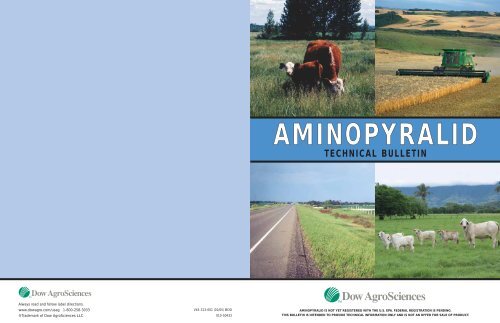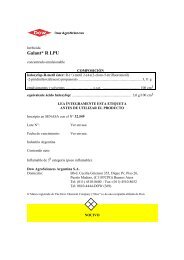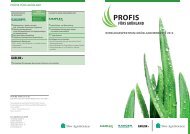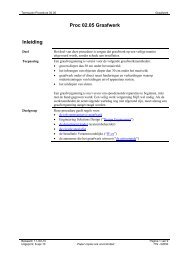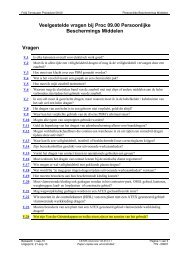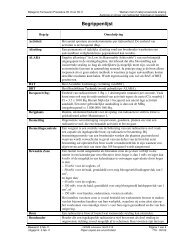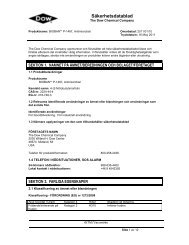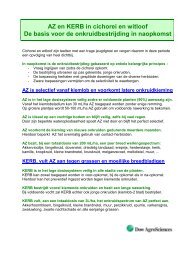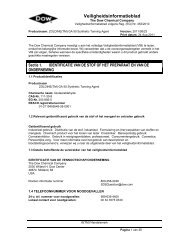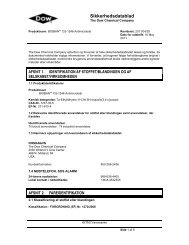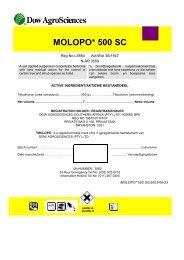AMINOPYRALID - The Dow Chemical Company
AMINOPYRALID - The Dow Chemical Company
AMINOPYRALID - The Dow Chemical Company
Create successful ePaper yourself
Turn your PDF publications into a flip-book with our unique Google optimized e-Paper software.
Always read and follow label directions.<br />
www.dowagro.com/usag 1-800-258-3033<br />
®Trademark of <strong>Dow</strong> AgroSciences LLC<br />
V45-313-001 (01/05) BOD<br />
010-50433<br />
<strong>AMINOPYRALID</strong><br />
TECHNICAL BULLETIN<br />
<strong>AMINOPYRALID</strong> IS NOT YET REGISTERED WITH THE U.S. EPA. FEDERAL REGISTRATION IS PENDING.<br />
THIS BULLETIN IS INTENDED TO PROVIDE TECHNICAL INFORMATION ONLY AND IS NOT AN OFFER FOR SALE OF PRODUCT.
Overview<br />
Aminopyralid (DE-750) is a new pyridine carboxylic acid herbicide intended for use in rangeland,<br />
permanent grass pastures, industrial vegetation management areas (including rights-of-way for roads,<br />
railroads and electric utility lines), natural areas (wildlife management areas, natural recreation areas,<br />
campgrounds, trailheads and trails), grazed areas in and around these sites, wheat, barley, sorghum<br />
and oil palm and rubber plantations. It is a new <strong>Dow</strong> AgroSciences compound designed and developed<br />
specifically for the control of noxious and invasive weed species in rangeland, pastures and industrial<br />
vegetation management sites. Aminopyralid is a new generation active ingredient that is effective at<br />
very low rates as compared to currently registered herbicides with the same mode of action, including<br />
2,4-D, clopyralid, triclopyr, picloram and dicamba. Aminopyralid is a broadleaf weed herbicide that<br />
provides systemic, postemergence control of noxious and invasive annual, biennial and perennial weed<br />
species, agronomically important weeds and certain semi-woody plants. Aminopyralid can provide<br />
residual control, thus reducing the need for re-treatment, depending on the rate applied and the target weeds.<br />
Once registered and commercialized, aminopyralid will be offered as a stand-alone treatment and in<br />
premixes with 2,4-D, fluroxypyr and triclopyr for use in rangeland, pastures, rights-of-way and natural<br />
areas. <strong>Dow</strong> AgroSciences intends to register aminopyralid globally. Applied as a stand-alone treatment,<br />
aminopyralid will control important invasive pasture weeds, including Acroptilon repens, Carduus<br />
nutans, Centaurea maculosa, Centaurea solstitialis, Cirsium arvense, Solanum viarum and Senecio<br />
jacobaea. Aminopyralid premixes, with other herbicides, will provide control of a broad spectrum of<br />
broadleaf weeds, including species in the genera Vernonia, Rumex, Urtica, Sida, Solidago, Vervain,<br />
Acacia and Mimosa.<br />
In wheat, aminopyralid can be applied for selective, postemergence control of key broadleaf weeds,<br />
including Polygonum convolvulus, Papaver rhoeas, Polygonum aviculare, Silybum marianum and<br />
Chrysanthemum segetum. Additional cereals concepts utilize fluroxypyr and florasulam as premix partners<br />
and metsulfuron in a co-pack. Product concepts for aminopyralid in wheat are being developed for use<br />
in Argentina, Australia, the United States, Europe, the middle East and Africa.<br />
Cirsium arvense Carduus nutans<br />
Additional product concepts being developed are for the use of aminopyralid + glyphosate in oil palm<br />
and rubber plantations; and aminopyralid + fluroxypyr for use in sorghum. Aminopyralid is selective<br />
in oilseed rape in Europe in concepts that will allow excellent control of a number of key dicot weeds,<br />
including species of Cirsium, Matricaria, Polygonum, Papaver, Galium and Geranium. Evaluations of the<br />
potential to develop aminopyralid alone or in co-formulation with other active ingredients in oilseed<br />
rape are ongoing.<br />
Noteworthy Features<br />
Aminopyralid was accepted for evaluation under the EPA’s Reduced Risk Pesticide program in October<br />
2004. Aminopyralid was accepted into this program based upon a combination of unique and improved<br />
features for the control of invasive weeds in rangeland, pastures, and non-cropland, compared to<br />
currently registered products. EPA’s decision to evaluate aminopyralid as part of its Reduced Risk initiative<br />
was based on data and risk assessments presented for toxicological, ecotoxicological and environmental<br />
fate effects.<br />
Aminopyralid applied alone and with other herbicides will provide the following attributes:<br />
Matricaria inodora<br />
1. Equivalent or superior postemergence and residual control of a broad spectrum of difficult-to-control<br />
noxious and invasive broadleaf or semi-woody plants compared to currently registered herbicides.<br />
2. Reduction in environmental herbicide loading in rangeland and pastures, industrial vegetation<br />
management areas, and natural areas by offering excellent control of many key species at rates<br />
substantially lower than labeled use rates for many currently registered herbicides.<br />
3. Residual weed control activity to reduce the need for re-treatment.<br />
4. An excellent fit into integrated weed management (IWM) programs.<br />
5. Efficacious control in cereals of Polygonum convolvulus, Polygonum aviculare, Papaver rhoeas<br />
(including ALS resistant and 2,4-D tolerant biotypes) and other broadleaf weeds<br />
6. Excellent tolerance and improved, weed free growth of perennial temperate and tropical forage<br />
grass species and grass crops such as wheat, barley and sorghum when used as recommended.<br />
7. A mode of action that provides an alternative to ALS-inhibitor herbicides for ALS herbicide resistant weeds.<br />
2 An Introduction to <strong>AMINOPYRALID</strong> An Introduction to <strong>AMINOPYRALID</strong> 3
<strong>The</strong> Aminopyralid Story<br />
Unmet Needs in Rangeland and Pastures,<br />
Rights-of-Way and Wildlife Management Areas<br />
One of the most serious problems facing landowners and<br />
land managers for rangeland and pastures, rights-of-way<br />
and natural areas is the rapid spread of noxious and<br />
invasive plants. Non-native invasive plants have been<br />
introduced into new habitats without the natural enemies<br />
that limited their reproduction and spread in their native<br />
habitats. <strong>The</strong>se invasive plants are spreading rapidly in<br />
many areas. <strong>The</strong> infestation rate on Federal lands in the<br />
U.S. is now approximately 4,600 acres per day 1 . <strong>The</strong> U.S.<br />
Geological Survey reports that some $20 billion in<br />
damages can be linked to invasive plants. When left<br />
uncontrolled, invasive weed species are a form of biological<br />
pollution and produce many direct and secondary negative<br />
effects. <strong>The</strong>se effects include the creation of plant monocultures that negatively impact endangered<br />
species, crowd out native species that are essential to properly functioning ecosystems, reduce production<br />
of forages used by game and livestock through competition and allelopathy, reduce rangeland carrying<br />
capacity, increase livestock production costs, increase soil erosion, increase rights-of-way maintenance needs<br />
and degrade the aesthetic qualities of desired plant communities.<br />
<strong>Dow</strong> AgroSciences has been a leader in providing effective herbicides for use in rangeland, pastures,<br />
rights-of-way and natural areas for many years. Continuing in this tradition, <strong>Dow</strong> AgroSciences is<br />
developing aminopyralid as a new active ingredient specifically designed for the management of noxious<br />
and invasive species and broad spectrum, broadleaf weed control in rangeland, pastures and rights-of-way.<br />
Aminopyralid is a new generation active ingredient of the pyridine carboxylic acid class that provides an<br />
effective tool for managing these difficult-to-control weeds using reduced application rates. Aminopyralid<br />
fits well into an integrated weed management program due to the low use rate. Overall, aminopyralid<br />
should prove to be a valuable tool in integrated systems approaches to managing rangeland, pasture,<br />
rights-of-way, non-cropland and natural area vegetation complexes.<br />
1 Asher and Harman, International J. of Wilderness 1(2) 1995. 35-37<br />
Formulations<br />
<strong>The</strong>re are currently a wide range of aminopyralid formulation concepts in development to meet widely<br />
varying user needs in different geographic areas and crops around the world. Each of these concepts is<br />
designed to address specific weed management objectives. In some situations, aminopyralid will be<br />
sold in products in which it is a single active ingredient. To meet other specific needs, aminopyralid will<br />
be offered in mixtures or combinations with additional active ingredients.<br />
Registrations<br />
<strong>Dow</strong> AgroSciences will seek to register aminopyralid for use in more than 50 countries in North<br />
America, Central and South America, Europe, Asia, Australia and New Zealand. Initial aminopyralid<br />
registrations are anticipated from 2005 through 2008.<br />
4 An Introduction to <strong>AMINOPYRALID</strong> An Introduction to <strong>AMINOPYRALID</strong> 5
Weed Control<br />
Vernonia baldwinii Solanum carolinense Mimosa pudica<br />
Aminopyralid products will provide selective, broad-spectrum control of annual, biennial and perennial<br />
broadleaf and semi-woody plants. Products are being developed for use in rangeland, pastures, industrial<br />
vegetation management areas, cereals, oil palm and rubber plantations.<br />
I. Range and Pasture, Rights-of-way and Natural Areas<br />
Aminopyralid controls a number of invasive plants and noxious weeds, woody and semi-woody plants<br />
including most of the species from the genera Acacia and Mimosa. Some woody and semi-woody<br />
species are treated on an individual plant basis. Aminopyralid will be recommended alone and or<br />
in pre-mixes with other herbicides.<br />
Long-term weed control is most effective where grass and other desirable vegetation form competitive<br />
stands after the aminopyralid application. <strong>The</strong> benefits of weed control achieved with aminopyralid may<br />
be optimized and extended when integrated with other vegetation management practices (i.e., prescribed<br />
fire, grazing management, fertilization, planting improved temperate and tropical grass and legume<br />
forages, mechanical controls, biological controls, etc.) that promote recovery of desirable vegetation<br />
and increase forage production.<br />
<strong>The</strong> following tables provide a listing of key economic weed species that are susceptible to aminopyralid<br />
and its mixtures with 2,4-D, fluroxypyr or triclopyr, when applied as a broadcast (Table 1) or directed<br />
spray (Table 2) in rangeland, pastures, rights-of-way, other non-cropland and certain crops. Examples<br />
of these weeds include Daucus carota, Solidago sp., Rumex sp., Vernonia sp., Vervain sp., Lespedeza sp.,<br />
Ranunculus sp., Urtica sp., Taraxacum officinale, Symphoriocarpus occidentalis, Capsella bursa-pastoris<br />
and Lantana camara.<br />
Cirsium vulgare Lantana camara Sida rhombifolia<br />
Table 1. List of weeds controlled by aminopyralid and its mixtures in R&P as g ae/ha (broadcast)*<br />
Bayer Species Name Bayer Species Name Bayer Species Name Bayer Species Name<br />
Code Code Code Code<br />
Aminopyralid Aminopyralid + 2,4-D Aminopyralid + Fluroxypyr Aminopyralid + Triclopyr<br />
6 An Introduction to <strong>AMINOPYRALID</strong> An Introduction to <strong>AMINOPYRALID</strong> 7<br />
CENRE**<br />
AMASP<br />
AMBEL<br />
AMBPS<br />
AMBTR<br />
ARTAB<br />
CRUAC<br />
CRUNU<br />
CENDI**<br />
CENMA**<br />
CENSO<br />
CHYLE<br />
CIRAR<br />
CIRVU<br />
LACSE<br />
LAMAN<br />
MATIN<br />
RANBU<br />
RUMAC<br />
RUMCR<br />
RUMOB<br />
SENJA<br />
SOLVI<br />
VEEAT<br />
VENBA<br />
XANST<br />
Acroptilon repens<br />
Amaranthus spinosus<br />
Ambrosia artemisiifolia<br />
Ambrosia psilostachya<br />
Ambrosia trifida<br />
Artemisia absinthium<br />
Carduus acanthoides<br />
Carduus nutans<br />
Centaurea diffusa<br />
Centaurea maculosa<br />
Centaurea solstitialis<br />
Chrysanthemum leucantheum<br />
Cirsium arvense<br />
Cirsium vulgare<br />
Lactuca serriola<br />
Lamium amplexicaule<br />
Matricaria inodora<br />
Ranunculus bulbosus<br />
Rumex acetosa<br />
Rumex crispus<br />
Rumex obtusifolius<br />
Senecio jacobaea<br />
Solanum viarum<br />
Verbesina alternafolia<br />
Vernonia baldwinii<br />
Xanthium strumarium<br />
AMASP<br />
AMBEL<br />
AMBPS<br />
AMBPS<br />
ARTAB<br />
CENDI<br />
CENMA**<br />
CHYUV<br />
CHEAM<br />
CICIN<br />
CIRVU<br />
CVNCP<br />
DAUCA<br />
DEMIL<br />
EUPSQ<br />
GUEDR<br />
HENAM<br />
HPYSU<br />
IVAAN<br />
IVAXA<br />
SIDGZ<br />
SIDRH<br />
SIDSN<br />
SOLCA<br />
SOOMS<br />
SYPOC<br />
VEBST<br />
VENAL<br />
Amaranthus spinosus<br />
Ambrosia artemisiifolia<br />
Ambrosia psilostachya<br />
Ambrosia spilostachya<br />
Artemisia absinthium<br />
Centaurea diffusa<br />
Centaurea maculosa<br />
Tanacetum vulgare<br />
Chenopodium ambrosioides<br />
Cichorium intybus<br />
Cirsium vulgare<br />
Croton capitatus<br />
Daucus carota<br />
Desmanthus illinoensis<br />
Eupatorium squalidum<br />
Gutierrezia dracunculoides<br />
Helenium amarum<br />
Hyptis suaveolens<br />
Iva annua<br />
Iva xanthifolia<br />
Sida glaziovii<br />
Sida rhombifolia<br />
Sida santaremnensis<br />
Solanum carolinense<br />
Solidago missouriensis<br />
Symphoricarpos occidentalis<br />
Verbena stricta<br />
Vernonia altissima<br />
CAPBP<br />
CHEAL<br />
CIRAR<br />
CIRVU<br />
EUPSQ<br />
HERSP<br />
IVAXA<br />
MATCH<br />
POLCO<br />
RANRE<br />
RANSA<br />
RUMAC<br />
RUMCR<br />
RUMOB<br />
CASOB<br />
SIDGZ<br />
SIDRH<br />
SIDSN<br />
STEME<br />
TAROF<br />
URTDI<br />
VENPO<br />
VENWE<br />
Capsella bursa-pastoris<br />
Chenopodium album<br />
Cirsium arvense<br />
Cirsium vulgare<br />
Eupatorium squalidum<br />
Heracleum sphondylium<br />
Iva xanthifolia<br />
Matricaria chamomilla<br />
Polygonum convolvulus<br />
Ranunculus repens<br />
Ranunculus sardous<br />
Rumex acetosa<br />
Rumex crispus<br />
Rumex obtusifolius<br />
Senna obtusifolia<br />
Sida glaziovii<br />
Sida rhombifolia<br />
Sida santaremnensis<br />
Stellaria media<br />
Taraxacum officianale<br />
Urtica dioica<br />
Vernonia polyanthes<br />
Vernonia westiniana<br />
Bayer Species Name Bayer Species Name Bayer Species Name<br />
Code Code Code<br />
Aminopyralid Aminopyralid + 2,4-D Aminopyralid + Fluroxypyr<br />
AROCA<br />
CRUNU<br />
CIRVU<br />
RUMOB<br />
SENJA<br />
SLYMA<br />
Arctotheca calendula<br />
Carduus nutans<br />
Cirsium vulgare<br />
Rumex obtusifolius<br />
Senecio jacobaea<br />
Silybum marianum<br />
ACACO<br />
ACAFA<br />
ACAPT<br />
ASCCU<br />
BATRE<br />
BOICA<br />
LIPNO<br />
MEOPA<br />
MIMAL<br />
MIMPI<br />
MIMPU<br />
CASTO<br />
SIDAC<br />
SIDRH<br />
SOLJA<br />
WSSAM<br />
Acacia cornigera<br />
Acacia farnesiana<br />
Acacia pennatula<br />
Asclepias curassavica<br />
Baltimora recta<br />
Borreria capitata<br />
Lippia nodiflora<br />
Melochia parviflora<br />
Mimosa albida<br />
Mimosa pigra<br />
Mimosa pudica<br />
Senna obtusifolia<br />
Sida acuta<br />
Sida rhombifolia<br />
Solanum jazminoide<br />
Wissadula amplissima<br />
ACADE<br />
ACAHA<br />
ACALE<br />
ACASC<br />
EUPAD<br />
EUPRI<br />
LANCA<br />
LANMV<br />
MACCO<br />
MALPA<br />
RUMSS<br />
Acacia decora<br />
Acacia harpophylla<br />
Acacia leiocalyx<br />
Acacia salicina<br />
Ageratina adenophora<br />
Ageratina riparia<br />
Lantana camara<br />
Lantana montevidensis<br />
Maclura chinensis<br />
Malva parviflora<br />
Rumex sp.<br />
CAPBP<br />
CHEAL<br />
CIRAR<br />
CIRVU<br />
HERSP<br />
MATCH<br />
RUMCR<br />
RUMOB<br />
TAROF<br />
URTDI<br />
Capsella bursa-pastoris<br />
Chenopodium album<br />
Cirsium arvense<br />
Cirsium vulgare<br />
Heracleum sphondylium<br />
Matricaria chamomilla<br />
Rumex crispus<br />
Rumex obtusifolius<br />
Taraxacum officinale<br />
Urtica dioica<br />
* <strong>Dow</strong> AgroSciences research<br />
** Rating base on control achieved one year after application of aminopyralid.<br />
For specific geographic and crop conditions, end-users should consult their local product labels and/or contact a <strong>Dow</strong> AgroSciences representative.<br />
Table 2. List of weeds controlled by aminopyralid and its mixtures in R&P as g ae/100L (directed)<br />
For specific geographic and crop conditions, end-users should consult their local product labels and/or contact a <strong>Dow</strong> AgroSciences representative.
II. Cereals – All Areas<br />
In wheat, aminopyralid has shown excellent postemergence<br />
control, as well as residual activity on key broadleaf weeds,<br />
including Polygonum convolvulus, Papaver rhoeas (including<br />
ALS resistant and 2,4-D tolerant biotypes), Polygonum aviculare,<br />
Silybum marianum and Chrysanthemum segetum. <strong>Dow</strong><br />
AgroSciences will recommend aminopyralid + fluroxypyr in<br />
Australia and in the United States for the control of<br />
Polygonum convolvulus, Polygonum aviculare, Polygonum<br />
vaccinifolium and Kochia scoparia. In Europe, Asia and Africa,<br />
<strong>Dow</strong> AgroSciences will seek registration of aminopyralid in<br />
mixtures designed for specific weed management needs.<br />
Use rates for aminopyralid in wheat will vary from 4 g ae/ha<br />
to 10 g ae/ha. Table 3 lists cereal weeds that are susceptible<br />
to aminopyralid alone and in mixtures.<br />
Table 3. List of weeds controlled by aminopyralid and its mixtures in cereals as g ae/ha (broadcast)<br />
Bayer Species Name Bayer Species Name Bayer Species Name Bayer Species Name<br />
Code Code Code Code<br />
Aminopyralid Aminopyralid + Fluroxypyr Aminopyralid + Florasulam Aminopyralid + Metsulfuron<br />
AROCA<br />
CHYSE<br />
CIEAR<br />
EMEAU<br />
LACSE<br />
MATSS<br />
PAPRH<br />
PIBSA<br />
POLAV<br />
POLCO<br />
SLYMA<br />
VICFX<br />
VICSA<br />
Arctotheca calendula<br />
Chrysentemum segetum<br />
Cicer arietinum*<br />
Emex australis<br />
Lactuca serriola<br />
Matricaria spp.<br />
Papaver rhoeas<br />
Pisum sativum*<br />
Polygonum aviculare<br />
Polygonum convolvulus<br />
Silybum marianum<br />
Vicia faba*<br />
Vicia sativa*<br />
KCHSC<br />
LACSE<br />
PAPRH<br />
POLCO<br />
Kochia scoparia<br />
Lactuca serriola<br />
Papaver rhoeas<br />
Polygonum convolvulus<br />
ANTAR<br />
BIFRA<br />
CIRAR<br />
GALAP<br />
MATSS<br />
PAPRH<br />
SINAR<br />
STEME<br />
Anthemis arvensis<br />
Bifora radians<br />
Cirsium arvense<br />
Galium aparine<br />
Matricaria spp.<br />
Papaver rhoeas<br />
Sinapis arvensis<br />
Stellaria media<br />
Triticum aestivum<br />
CENSO<br />
CHEAL<br />
LAMAM<br />
LYCAR<br />
POLAV<br />
POLCO<br />
RAPRA<br />
RASRU<br />
STEME<br />
Centaurea solstitialis<br />
Chenopodium album<br />
Lamium amplexicaule<br />
Lycopsis arvensis<br />
Polygonum aviculare<br />
Polygonum convolvulus<br />
Raphanus raphanistrum<br />
Rapistrum rugosum<br />
Stellaria media<br />
* volunteer plants<br />
For specific geographic and crop conditions, end-users should consult their local product labels and/or contact a <strong>Dow</strong> AgroSciences representative.<br />
III. Oil Palm and Rubber Plantations – Indonesia and Malaysia<br />
<strong>Dow</strong> AgroSciences is developing a premixture of aminopyralid + glyphosate for use in oil palm and rubber<br />
plantations as a postemergence treatment applied around the base of the trees for broad spectrum<br />
foliar control of key broadleaf and grass weeds including Ageratum conyzoides, Asystasia intrusa,<br />
Hedyotis verticillata, Mikania cordata and Paspalum conjugatum.<br />
Mode of Action<br />
Silybum marianum Polygonum convolvulus Polygonum aviculare<br />
Hedyotis verticillata Ageratum conizoides<br />
Plant growth is a complex process that is controlled, in part, by a variety of plant growth regulators,<br />
including auxin compounds. To ensure proper growth, plants produce very controlled amounts of these<br />
materials. Auxins bind to specific cell surface receptor proteins, turning on and off vital plant processes.<br />
Aminopyralid is a herbicide possessing auxin-like qualities. Aminopyralid moves systemically throughout<br />
the plant and deregulates plant growth metabolic pathways affecting the growth process of the plant.<br />
This disruption of plant growth processes, by binding of aminopyralid at receptor sites normally used<br />
by the plant’s natural growth hormones, results in control and death of susceptible plant species.<br />
8 An Introduction to <strong>AMINOPYRALID</strong> An Introduction to <strong>AMINOPYRALID</strong> 9
Absorption/Translocation<br />
Aminopyralid is a systemic, phloem and xylem mobile herbicide that is rapidly absorbed by the leaves<br />
and roots. <strong>The</strong> compound translocates throughout the plant and accumulates in the meristematic tissue,<br />
resulting in uneven cell division and growth.<br />
Herbicidal Activity<br />
Symptoms are typical of those for the auxinic mode of action. Within hours or days of application<br />
depending on the weed species, aminopyralid causes symptoms such as thickened, curved and twisted<br />
stems and leaves, cupping and crinkling of leaves, stem cracking, narrow leaves with callus tissue,<br />
hardened growth on stems, enlarged roots and proliferated growth. Most annual susceptible weeds are<br />
controlled within 4 to 8 weeks after application. Complete kill of main stems and the root systems of<br />
woody and semi-woody plants may require 2 or more months after application. Plant growth will stop<br />
within 24-48 hours after treatment.<br />
Crop Tolerance<br />
Aminopyralid offers a high level of tolerance on a wide range of temperate and tropical forage grasses<br />
and on small grain cereals. More than 20 different forage grasses evaluated in field trials from 1999-2004,<br />
with aminopyralid applied at rates up to 2 times the maximum use rate, demonstrated tolerance to<br />
aminopyralid. <strong>The</strong> grasses evaluated included Agropyron sp., Andropogon gerardii, Andropogon<br />
saccharoides, Andropogon scoparius, Bouteloua curtipendula, Bouteloua gracilis, Brachiaria bryzantha,<br />
Brachiaria decumbens, Bromus inermis, Buchloe dactyloides, Cynodon dactylon, Cynodon nlemfuensis,<br />
Cynodon plectostachyus, Dactylis glomerata, Digitaria decumbens, Eragrostis ciliaris, Festuca sp., Lolium<br />
sp., Panicum maximum, Panicum virgatum, Paspalum notatum, Phleum pratense, Poa sp. and<br />
Sorghastrum nutans.<br />
Aminopyralid may be applied to small grain cereals from the 3-leaf crop growth stage up to the early<br />
joint stage. Field trial results confirm that aminopyralid offers crop selectivity that is equal or superior<br />
to that of standards on wheat, durum wheat, barley, rye and triticale.<br />
Crop Rotation<br />
Rangeland or permanent pasture areas treated with aminopyralid should generally not be rotated to broadleaf<br />
crops including cotton, soybeans, alfalfa, field peas, lentils and other leguminous crops within the same year<br />
of application. Exceptions might occur in tropical/subtropical regions with hot and humid conditions.<br />
Aminopyralid is primarily dissipated in the soil by aerobic microbial degradation and the rate of breakdown<br />
is dependent upon several factors including soil moisture and soil temperature. Specific local guidelines for<br />
planting of rotational crops will be contained on the label. In general, grass crops will be more tolerant as<br />
rotational crops. Rotational crop recommendations for broadleaf crops will vary among species.<br />
Resistance Management<br />
Aminopyralid has an auxinic growth regulator mode of action. Other growth regulator herbicides used<br />
on rangeland and pastures, rights-of-way and other non-cropland areas, natural areas and in cereals,<br />
include 2,4-D, clopyralid, dicamba, picloram and triclopyr. Despite extensive use, herbicides with this mode<br />
of action have demonstrated a low risk of resistance development compared to other herbicide<br />
mode of action classifications such as ALS-inhibitor herbicides, photosystem II inhibitor herbicides<br />
and ACCase-inhibitor herbicides.<br />
<strong>The</strong> International Survey of Resistant Weeds lists only six weed species in the United States and 24 species<br />
worldwide with resistance to the growth regulator mode of action. <strong>The</strong> risk of resistance development is<br />
less on rangeland, pasture and natural areas because herbicide applications are not typically made every<br />
year, thus slowing the increase in resistant genotypes in weed populations. Because of the low resistance<br />
risk, aminopyralid will be a useful herbicide tool to rotate with ALS-inhibitor herbicides and urea herbicides<br />
in range and pastures, non-cropland areas and natural areas.<br />
Worldwide, there currently are 82 weed species with confirmed ALS-inhibitor resistance and 20 with urea<br />
herbicide resistance. Many of these weed biotypes are encountered in rangeland, pastures, rights-of-way<br />
and cereals including Kochia scoparia, Salsola iberica, Papaver rhoeas, Ambrosia sp., Lactuca serriola,<br />
Helianthus annuus, Sinapis arvensis and Amaranthus sp.<br />
Chlorsufuron and sulfometuron are ALS-inhibiting herbicides that have been used repeatedly and extensively<br />
on rights-of-way. Metsulfuron, another ALS-inhibiting herbicide, has been used repeatedly and extensively<br />
on rights-of-way, rangeland and pastures. Triasulfuron, chlorsulfuron, metsulfuron, thifensulfuron and tribenuron<br />
are ALS-inhibiting herbicides that have been used repeatedly and extensively on wheat.<br />
<strong>The</strong>re are only a limited number of herbicide modes-of-action available for rangeland, pasture and<br />
non-cropland areas. <strong>The</strong> existence of multiple known examples of ALS-inhibitor resistant weeds in these<br />
sites and in wheat, confirm the need for a sound weed resistance management strategy. Aminopyralid has<br />
a growth regulator mode of action and will control ALS-inhibitor herbicide and urea herbicide resistant<br />
biotypes for species within the aminopyralid weed spectrum.<br />
10 An Introduction to <strong>AMINOPYRALID</strong> An Introduction to <strong>AMINOPYRALID</strong> 11
Description of Chemistry<br />
<strong>Chemical</strong> Name (IUPAC) 4-amino-3,6-dichloropyridine-2-carboxylic acid<br />
<strong>Chemical</strong> Name (CAS) 2-pyridinecarboxylic acid, 4-amino-3,6-dichloro-<br />
Common Name Aminopyralid (ISO proposed)<br />
Code Names DE-750, XDE-750, XR-750<br />
<strong>Chemical</strong> Class Pyridine carboxylic acid<br />
CAS Registry No. 150114-71-9<br />
Empirical formula C 6 H 4 Cl 2 N 2 O 2<br />
Structural formula<br />
Molecular Weight 207.026 g/mole<br />
Relative Density 1.72 at 20°C<br />
Appearance Off-white, odorless powder<br />
Melting Point 163.5°C<br />
Boiling Point Decomposes upon melting<br />
Vapor pressure At 20°C, 7.14e-11 mmHg<br />
Octanol/Water Partition Unbuffered water = 0.201<br />
Coefficient (log K ow ) at 19°C pH 5 = -1.76<br />
pH 7 = -2.87<br />
pH 9 = -2.96<br />
Dissociation Constant (pK a ) 2.56<br />
Hydrolytic Stability (DT 50 ) Stable<br />
Aqueous Photostability (DT 50 ) 0.6 Days<br />
Soil Photolysis (DT 50 ) 61 Days<br />
Solubility in water 2.48<br />
(g/L @ 18°C)<br />
Solvent solubility<br />
(g/L @ 20°C)<br />
Buffered water pH = 5 212 g/L<br />
Buffered water pH = 7 205 g/L<br />
Buffered water pH = 9 203 g/L<br />
Methanol 52 g/L<br />
Acetone 29 g/L<br />
Heptane Insoluble (< 10 µg/L)<br />
12 An Introduction to <strong>AMINOPYRALID</strong> An Introduction to <strong>AMINOPYRALID</strong> 13
Mammalian Toxicity<br />
I. Short-Term (Acute) Toxicity<br />
Based on data generated for, or on behalf of <strong>Dow</strong> AgroSciences, the acute mammalian toxicity of<br />
aminopyralid is considered low for both technical and end-use formulations. <strong>The</strong> acute oral LD 50 and<br />
dermal LD 50 in rats were greater than 5000 mg/kg, respectively, while the acute inhalation LC 50 was<br />
greater than 5.5 mg/L. Dermal irritation was negative for the aminopyralid technical. Eye irritation ranged from<br />
a slight, transient irritation for formulated aminopyralid to irritating for aminopyralid technical. Aminopyralid<br />
was not a skin sensitizer. A summary of acute toxicology data for aminopyralid is provided below:<br />
Test Species Toxicity Parameters<br />
Acute Oral (technical ai) Rat LD 50 > 5000 mg/kg<br />
Acute Oral (GF-871, Rat LD 50 > 5000 mg/kg<br />
240 g ae/L formulation)<br />
Acute Dermal (technical ai) Rat LD 50 > 5000 mg/kg<br />
Acute Dermal (GF-871, Rat LD 50 > 5000 mg/kg<br />
240 g ae/L formulation)<br />
Acute Inhalation (technical ai) Rat LC 50 male > 5.50 mg/L<br />
Acute Inhalation (GF-871, Rat LC 50 male > 5.79 mg/L<br />
240 g ae/L formulation)<br />
Dermal irritation (technical ai) Rabbit Negative<br />
Dermal irritation (GF-871, Rabbit Slight irritation<br />
240 g ae/L formulation)<br />
Eye Irritation (technical ai) Rabbit Irritating<br />
Eye Irritation (GF-871, Rabbit Slight irritation,<br />
240 g ae/L formulation) resolving within 24 hours<br />
Skin sensitization (technical ai) Guinea Pig No sensitization<br />
Skin sensitization (GF-871, Guinea Pig No sensitization<br />
240 g ae/L formulation)<br />
Long-Term (Chronic) Toxicity<br />
<strong>Dow</strong> AgroSciences studies have shown that aminopyralid (technical) was not carcinogenic,<br />
teratogenic, mutagenic, neurotoxic or a reproductive hazard. Aminopyralid was tested<br />
for genotoxicity in both in vitro and in vivo systems. A summary of long-term (chronic)<br />
toxicity data is provided below:<br />
Test Species Toxicity Parameters<br />
2-year chronic feeding Rat Not carcinogenic<br />
NOAEL (mg/kg/day):<br />
Male = 50, Female = 500<br />
Teratogenicity Rat Not teratogenic<br />
NOAEL (mg/kg/day):<br />
Maternal = 1000<br />
Developmental = 1000<br />
Teratogenicity Rabbit Not teratogenic<br />
NOAEL (mg/kg/day):<br />
Maternal = 250<br />
Developmental = 500<br />
Reproductive toxicity Rat No adverse reproductive effects<br />
NOAEL (mg/kg/day):<br />
Parental = 1000<br />
Reproductive = 1000<br />
Acute and chronic neurotoxicity Rat No adverse neurological effects<br />
Mutagenicity Assay (in vitro) Ames test Negative<br />
Mutagenicity Assay (in vitro) CHO/HGPRT Negative<br />
Mutagenicity Assay (in vivo) Mouse micronucleus Negative<br />
NOAEL (mg/kg/day) = 1000<br />
14 An Introduction to <strong>AMINOPYRALID</strong> An Introduction to <strong>AMINOPYRALID</strong> 15
Environmental Toxicology<br />
In <strong>Dow</strong> AgroSciences laboratory testing, aminopyralid has been shown to be practically non-toxic to<br />
birds, fish, honeybees, earthworms and aquatic invertebrates. While aminopyralid is slightly toxic to the<br />
eastern oyster, algae and aquatic vascular plants, the expected environmental concentration resulting<br />
from the use of this material for weed control is orders of magnitude below any level of concern established<br />
for these organisms by EPA.<br />
Study Species Value<br />
Birds<br />
Avian oral Bobwhite Quail LD 50 > 2250 mg ae/kg bw<br />
Avian dietary Bobwhite Quail LD 50 > 5620 mg ae/kg diet<br />
Avian dietary Mallard Duck LD 50 > 5620 mg ae/kg diet<br />
Fish<br />
Acute toxicity Rainbow Trout 96 hr LC 50 > 100 mg ae/L<br />
Acute toxicity Bluegill 96 hr LC 50 > 100 mg ae/L<br />
Acute toxicity Sheepshead Minnow 96 hr LC 50 > 120 mg ae/L<br />
Study Species Value<br />
Aquatic Invertebrates<br />
Acute toxicity Water flea 48 hr EC 50 > 100 mg ae/L<br />
(Daphnia magna)<br />
Acute toxicity Mysid shrimp 96 hr LC 50 > 100 mg ae/L<br />
Acute toxicity Eastern oyster Slightly toxic<br />
48 hr EC 50 > 89 mg ae/L<br />
Growth and Reproduction Water flea NOEC = 100 mg ae/L<br />
(Daphnia magna)<br />
Chronic Toxicity Midge NOEC = 130 mg ae/L<br />
16 An Introduction to <strong>AMINOPYRALID</strong> An Introduction to <strong>AMINOPYRALID</strong> 17<br />
Honey bees<br />
Acute Contact Honeybee 48 hr LD 50 > 100 ug ae/bee<br />
Acute Oral Honeybee 48 hr LD 50 > 120 ug ae/bee<br />
Earthworm<br />
Acute Toxicity Earthworm 14 d LC 50 > 1000 mg ae/kg soil<br />
Algae and Aquatic Plants<br />
Acute Toxicity Freshwater green algae Slightly toxic<br />
72 hr E r C 50 = 30 mg ae/L<br />
Acute Toxicity Freshwater Slightly toxic<br />
blue-green algae 120 hr EC 50 = 27 mg ae/L<br />
Acute Toxicity Saltwater diatom Slightly toxic<br />
72 hr E b C 50 = 77 mg ae/L<br />
Acute Toxicity Freshwater diatom Slightly toxic<br />
96 hr EC 50 = 14 mg ae/L<br />
Acute Toxicity Duckweed Slightly toxic<br />
(Lemna gibba) 14 d EC 50 > 88 mg ae/L
Environmental Fate<br />
Soil<br />
Aerobic microbial degradation is the primary route of breakdown of aminopyralid in soil. <strong>The</strong> rate of<br />
degradation in the field resulted in an average half-life of 34.5 days for 8 North American sites and<br />
25 days for four European sites.<br />
Laboratory experiments yielded an average K oc of 10.8 L/kg, indicating some potential for mobility.<br />
However, field experiments showed limited movement in the soil profile. No degradation metabolites<br />
of concern were produced in any studies.<br />
Water<br />
In water the primary route of degradation of aminopyralid is photolysis. <strong>The</strong> photolysis half-life under standard<br />
conditions is 0.6 days indicating rapid degradation in surface water. <strong>The</strong> material is stable to hydrolysis.<br />
Groundwater contamination potential for aminopyralid is considered to be low because of low use<br />
rates, the moderate field degradation rates and limited mobility observed in field studies. Using this<br />
information as inputs to EPA and European Union simulation models, aminopyralid demonstrated a low<br />
potential for groundwater contamination.<br />
Air<br />
<strong>The</strong> potential for transport of aminopyralid via<br />
volatilization of residues is extremely low, due to its<br />
low vapor pressure and small Henry’s Law constant.<br />
As with any herbicide, susceptible non-target<br />
plants may be injured via physical spray drift.<br />
Spray applications should be made such that<br />
spray drift cannot injure desirable, susceptible<br />
plant species.<br />
Disclaimer<br />
<strong>The</strong> Aminopyralid Technical Bulletin is provided for reference purposes only and is not a substitute for<br />
or an addition to the product label or MSDS. Always read and follow label directions for registered pesticides.<br />
<strong>The</strong> information and any recommendations in this bulletin (“Information”) are presented in good faith;<br />
however, <strong>Dow</strong> AgroSciences LLC makes no warranty as to the completeness or accuracy of the information.<br />
This information is supplied upon the condition that persons receiving it will make their own determinations<br />
as to its suitability for their purposes prior to use and consult with their advisors to ensure compliance<br />
with all federal, state and local regulations. In no event will <strong>Dow</strong> AgroSciences be responsible for damages<br />
of any nature whatsoever resulting from the use of or reliance on this information.<br />
<strong>AMINOPYRALID</strong> IS NOT YET REGISTERED WITH THE U.S. EPA. FEDERAL REGISTRATION IS<br />
PENDING. THIS BULLETIN IS INTENDED TO PROVIDE TECHNICAL INFORMATION ONLY AND<br />
IS NOT AN OFFER FOR SALE OF PRODUCT.<br />
NO REPRESENTATION OR WARRANTIES, EITHER EXPRESSED OR IMPLIED OF MERCHANTABILITY,<br />
FITNESS FOR A PARTICULAR PURPOSE OR OF ANY OTHER NATURE ARE MADE HERUNDER WITH<br />
RESPECT TO THE INFORMATION OR THE PRODUCTS TO WHICH THE INFORMATION REFERS.<br />
Notice to the State of New York: <strong>The</strong> conclusions which are contained with this Technical Bulletin<br />
relating to the toxicological and environmental properties and effects of aminopyralid are based on<br />
research and studies conducted by <strong>Dow</strong> AgroSciences. All such conclusions and findings are considered<br />
to be the opinions of <strong>Dow</strong> AgroSciences.<br />
18 An Introduction to <strong>AMINOPYRALID</strong> An Introduction to <strong>AMINOPYRALID</strong> 19


